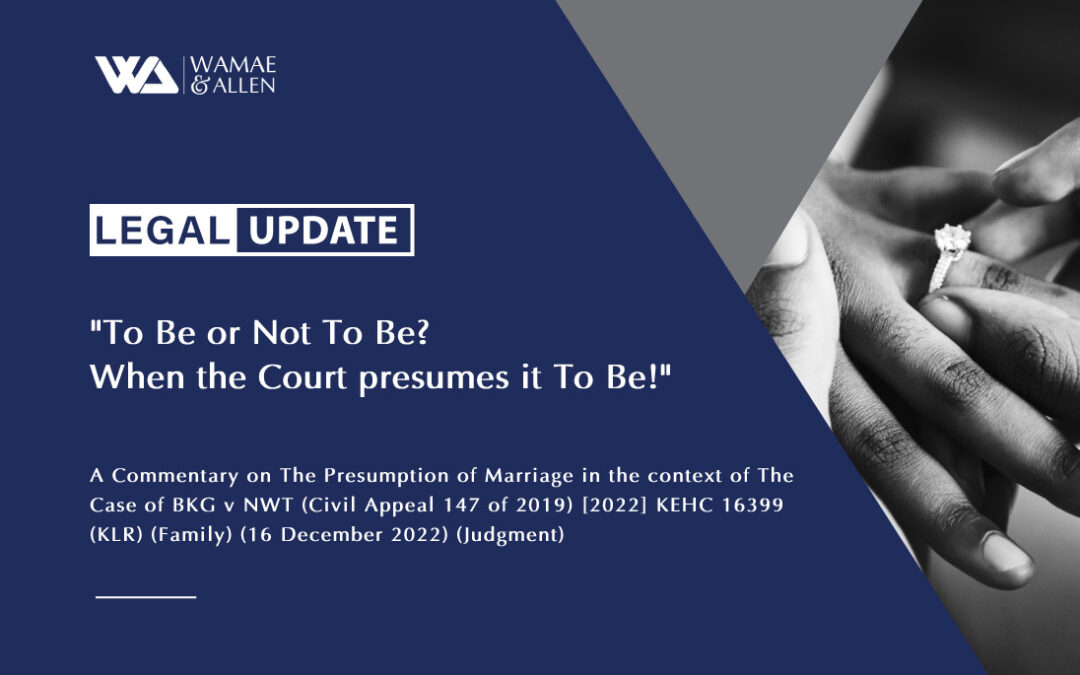Maureen A. Odero J, in BKG v NWT (Civil Appeal 147 of 2019) [2022] KEHC 16399 (KLR) (Family) (16 December 2022) (Judgment)
- INTRODUCTION
- Of late, a legal debate over cohabitation has become commonplace in court rooms throughout Kenya. We find it apposite to begin by emphasizing that the Marriage Act No.4 of 2014, apart from defining cohabitation, is silent on the legality of cohabitation as a form of marriage in Kenya. It is perhaps, this statutory silence that has muddied the waters, although we not the Act has aptly provided clarity on the definition of marriage in the Kenyan context. What has ensued has been a status of confusion and chaos in court decisions on the subject.
- THE LEGAL REGIME ON MARRIAGES IN KENYA.
- The preamble of the Marriage Act outlines that its purpose is to amend and consolidate the various laws relating to marriage and divorce. From the above, it is accurate to say that the marriage act is the primary source of law on matters. Prior to the enactment of the Marriage Act, 2014, the legal regime on marriage within Kenya was provided within the following now repleaded Acts;
- The Marriage Act Cap.150 Laws of Kenya
- The African Christian Marriage and Divorce Act. Cap. 151 Laws of Kenya
- The Matrimonial Cause Act Cap. 152 Laws of Kenya
- The Subordinate Court (Separation and Maintenance) Act Cap. 153 Laws of Kenya
- The Mohammed Marriage and Divorce Registration Act Cap. 155 Laws of Kenya
- The Mohammedan Marriage Divorce and Succession Act Cap 156 Laws of Kenya
- The Hindu Marriage and Divorce Act Cap. 157 of the Laws of Kenya.
- Following the independence of Kenya, there were various attempts to reform the act from two commissions appointed by former President Jomo Kenyatta in 1967 and further reforms in 1993 when the then Attorney General appointed a task force to review the relating to women in Kenya. Substantive legislation to marriage came after the promulgation of the Constitution of Kenya, 2010, Kiage (JA) in his literary works Family Law in Kenya; Marriage, Divorce and Children 2016 states;
“On a more practical level, though, the full realization of reforms in family law was to be achieved when Parliament fulfilled the task of enacting legislation recognising systems of personal and family law under any tradition adhered to by persons professing a particular religion and recognising also marriages concluded under any such tradition or system. This provided the perfect opportunity to push through Parliament the kind of legislation that would rationalise modernize and equalize family law not least because the law-making power would no longer be a heavily male-dominated affair owing to provisions for significant women representation in Parliament and public participation.
The much-anticipated legislation is the Marriage Act, No. 4 of 2014. Prima facie the Act seems to have adopted half a century, later, most of the recommendations made in 1968”
- Kiage (JA) further notes the salient features as follows;
- Consolidation of all matrimonial laws in Kenya under one statute.
- The recognition of both monogamous and polygamous unions
- The registration of marriages solemnized under customary law and issuance of certificates thereto
- The conversion of marriages from potentially polygamous to monogamous
- Agreements of separation between parties and enforcement thereof by courts of law
- Statutory provisions for attempts at reconciliation and mediation before seeking the court’s intervention over marital affairs
- Provision for the payment of maintenance for the other spouse irrespective of gender
- Provisions on offences and punishment thereof.
- However, as noted herein above, the writer also notes that despite the numerous information availed to the drafter, the so-called ‘perfect act’ failed to appreciate the following issues;
- Rights and duties of parties in cohabitation arrangements (commonly referred to as “come we stay” marriages);
- Conversion of monogamous marriages into polygamous unions;
- Pre-nuptial agreements;
- Rights and duties of parties involved in surrogacy and in-vitro fertilisation;
- Recognition (or not) of marriages entered into by intersex persons and same-sex marriages.
- DOCTRINE OF PRESUMPTION OF MARRIAGE
- As noted above, a somewhat lacuna in the Act has had some judicial officer breathe life into the doctrine of presumption of marriage. A common law doctrine that is applicable in Kenya in accordance with Section 3(1) of the Judicature Act. Therefore, prior to the enactment of the Marriage Act 2014, various decisions were made in favour of the doctrine, such as the more notable cases of Peter Hinga v Mary Wanjiku Nairobi Civil Appeal No. 94 of 1977, Yawe Hortensia v Public Trustee Civil Appeal Number 13 of 1976 and WM v Murigi [2008] 1 KLR (G&F) 348
- From the above-mentioned cases, presumption of marriage can be summaries as arising from the following characteristics inter alia;
- Long cohabitation between the parties who hold themselves out to be and be regarded by others as husband and wife
- There may be absences of a formal marriage ceremony under any other marriage regime.
- The doctrine seems to still be alive and in the case of BKG v NWT (Civil Appeal 147 of 2019) [2022] KEHC 16399 (KLR) (Family), Odero J, went to uphold the doctrine, which is the subject of this publication.
- CASE FACTS
- The Respondent had filed a Petition seeking the dissolution of her marriage to the Appellant. After hearing evidence from both parties, the learned trial magistrate found that indeed a presumption of marriage did exist between the couple. The court proceeded to dissolve the said marriage and directed that a Decree Nisi be issued. The Respondent’s case was that she got married to the Appellant in the year 2009 under Kikuyu Customary Law. That the couple cohabited as man and wife in the Ongata Rongai area of Kajiado County.
- The Respondent filed a Petition for divorce in the Chief Magistrates Court alleging adultery and cruelty by the Appellant. She told the court that the marriage had irretrievably broken down.
- On his part, the Appellant denied that he had ever married the Respondent under customary law or indeed under any other system of law. The appellant did however admit that he met and started a relationship with the Respondent.
Being aggrieved by the judgment of the subordinate court and particularly with the trial court finding that a marriage existed between the couple, the Appellant filed an appeal.
- THE RATIO DECIDENDI
-
- First, the judge made a finding that the evidence on record was clear that the respondent’s first marriage which was conducted under Kikuyu Customary law was dissolved according to Kikuyu Customary Law by refunding the dowry paid by the first husband. According to the evidence, it was the Appellant himself who gave out Kshs 35,000 to be given to the 1st husband as a refund of his dowry. Consequently, the judge found that the Appellant had the capacity to enter into another marriage.
- Secondly, the judge analysed the evidence to determine whether the Appellant and the Respondents were married under customary law. Here, the judge found that there was no kikuyu marriage because while the Appellant visited the Respondent’s parents, he never returned to complete the marriage rites as per custom.
- Consequently, the final issue for determination was whether from the evidence on record, a marriage could be presumed based on the famous Court of Appeal case of Hortensia Wanjiku Yawe – vs – Public Trustee [1976] KLR. It is quite axiomatic that the ratio of the Hortensia Yawe (supra) case and a catena of authorities following its ratio agree that cohabitation may lead to a presumed marriage if the parameters below are met:
- Long Cohabitation and repute
- Providing sustenance and shelter
- Treating the person as a spouse and the other family members treated him/her as such.
- Evidence of an intimate relationship
- Having children
- The neighbour principle- where a neighbour looking at the relationship would describe it as a marriage.
- How do the parties introduce themselves to people?
- Description of a party as a spouse in the official documents, such as medical insurance, retirement benefits, and insurance covers.
- The judge made a finding that the presumption of marriage criteria in Hortensia had been met since the parties had cohabited for close to 11 years, the Respondent had acquired an identity card incorporating the Appellant’s surname and the Appellant had introduced the Respondent as his wife to her family.
- The principles set out in Hortensia (Supra) have been applied in many cases, including the recent court of Appeal case of POM v MNK [2019] eKLR. However, a substantial number of courts have declined to recognise the principle of cohabitation or presumption of marriage such as CWN v DK [2021] eKLR, In Eva Naima Kaaka & Another vs. Tabitha Waithera Mararo (2018) eKLR, and In Eva Naima Kaaka & Another vs. Tabitha Waithera Mararo (2018) eKLR. This has led to uncertainty and confusion on the legal position of cohabitation. This uncertainty was acknowledged by the Supreme Court in the case of MNK v POM [2020], during the certification application, which noted that the issue of a general public importance. However, the substantive issue is pending determination.
- CONTRARY POSITION
- In the case of CWN v DK [2021] eKLR, the High Court held that presumption of marriage in Kenya was abolished by the enactment of the Marriage Act. The ratio of the Court’s decision was that the marriages enumerated in section 6 are the only marriages recognised in law in this country. Secondly, according to the judge, a presumption, whether or law or fact, would be applied to effectively oust clear and express provisions of the law. The judge also made a finding that section 3 of the marriage act requires mandatory registration, meaning the only proof or evidence as to the existence of a marriage is a certificate of marriage or an entry of the marriage register.
- Borrowing from comparative experience from other jurisdictions, the judge painstakingly advanced an argument that even in jurisdictions where the presumption of marriage is recognised, such unions do not have an equal status of a marriage. To that end, the judge’s analysis of the comparative experience was that many jurisdictions have since abolished common law marriages by requiring all marriages to be formalised and registered.
- In Scotland, cohabitation was until recently considered an ‘irregular marriage’ created by cohabitation. The Family Law (Scotland) Act, 2006 has now abolished such unions. In the United States, about nine states recognise ‘common law marriage’; it is recognised as a form of marriage in which a couple lives together for a period of time and holds out to friends, family and the community as ‘being married’ but without ever going through a formal ceremony or getting a marriage license or certificate which is a requirement that is common to all the 50 states. Even then, the couple must have lived together for some time the amount of which varies from one state to another; the couple must have the legal right or capacity to marry; they must have intended to marry; and, they must have held themselves out to the outside world as being a married couple.
- IMPLICATIONS OF THE JUDGMENT
- The writers herein are strongly in disagreement with the finding in BKG v NWT (Supra) for the following reasons;
- Several problems arise with upholding the presumption of marriage. The first argument that militates against the presumption of marriage is that consent is a requirement of a valid marriage under sections 3 and 11 of the Marriage Act. One may reasonably argue that the presumption of marriage raises questions about the need for consent, since there is no express consent in cohabitation, as contrasted from the kinds of marriages recognised under section 6 of the Marriage Act, 2014. In the case of POM V MNK(Supra), in the following terms Koome (JA) (as she then was)) expressed the view that the presumption of marriage presents serious controversies including:
“the constitutional interpretation of whether there can be a presumption of marriage where there is no consent; capacity of the parties to enter into multiple relationships including women and the principles of equality of ownership of property raise serious constitutional controversies.”
- Secondly, Section 3(1) of the Marriage Act defines marriage as “ the voluntary union of a man and a woman whether in a monogamous or polygamous union and registered in accordance with this Act.” This means that for a union to be considered a marriage, it must in addition to being voluntary, be registered in accordance with the Marriage Act. Furthermore, the marriage act in Sections 53, 54, and 55 uses the phrase “shall register” before all the provisions describing the mandatory requirement to register the different kinds of marriages recognised under the act. In the case of Republic v Non-Governmental Organizations Ex parte Linda Bonyo & 4 others; Philip Opiyo Sadjah & 5 others (Interested Parties) [2020] eKLR, Justice Mativo interpreted the word “shall” to mean mandatory. According to the Judge:
“60. The word “shall” when used in a statutory provision imports a form of command or mandate. It is not permissive, it is mandatory. The word shall in its ordinary meaning is a word of command which is normally given a compulsory meaning as it is intended to denote obligation.[25] The Longman Dictionary of the English Language states that “shall” is used to express a command or exhortation or what is legally mandatory.[26] Ordinarily the words ‘shall’ and ‘must’ are mandatory and the word ‘may’ is directory. The word shall does not appear in the above Regulation thrice for cosmetic purposes. A proper construction of the above Regulation leads me to the conclusion that it is mandatory. Had the drafter intended otherwise, he could have deployed the word “may” which is permissive.”
This begs the question: does word ‘shall’ as used in the above sections of the Marriage Act appear for cosmetic purpose? The inescapable conclusion is that the word “shall” means the requirement of registering all marriages is mandatory.
- Thirdly, under Section 59 of the Marriage Act, the only evidence of marriage is either a certificate of marriage, or an entry in the register of marriages or certified copies of the two documents. This means a cohabitation union does not meet the threshold of proof of marriage as required by the Act and Section 107 of the Evidence Act, which places the burden of proof on the person alleging.
- Fourthly, a cohabitation or common law union does not enjoy the same legal status, recognition and benefits as the marriages recognised under the Act, by virtue of Section 3(3) of the Marriage Act. Cohabitation is not on the same pedestal as statutory marriages.
- Lastly, Section 2 of the Marriage Act defines cohabitation as: “cohabit” “to live in an arrangement in which an unmarried couple lives together in a long-term relationship that resembles a marriage.” Three things that stand out of this definition are, one, regardless of what the intentions of a cohabiting couple may be, they do not acquire any other status than that of being unmarried and, two, perhaps to drive the point home, the relationship of the cohabiting couple only ‘resembles’ a marriage; in other words, it is not a marriage. The third aspect of this definition is, regardless of how long the couple lives together, the status of its legal relationship will not change. The sum of our argument is that when sections 2, 6, and 59 of the Marriage are read together, it is reasonable to conclude that presumption of marriage by cohabitation no longer stands on a solid foundation in our marriage law infrastructure.
- IMPLICATIONS OF THIS IN OTHER AREAS OF LAW.
- We note that the institution of marriage gives particular rights and obligations to the parties therein, which affect various other 3rd parties to the union. For instance, in credit facilities such as charges, a prerequisite document for registration of a charge and a charges statutory power sale a pegged on obtaining ‘spousal’ consent and issuance of notice to the spouse.
- The failure to undertake the above, is fatal as it shall void the terms of the charge or clog the ability of the chargee to exercise its statutory power of sale. Therefore, in the continuance adoption of the doctrine of presumption of marriage, courts are not only going against clear statutory provisions, which have not been repealed, or rendered unconstitutional by any court.
- Furthermore, in succession law, a spouse interest has been well catered for as a beneficial life interest. Therefore, in allowing the doctrine, it may give rise to estates being bequeathed to persons whom are not entitled to particular interests as spouses.
- CONCLUSION
- As is well established, statutes rank superior to common law, therefore, there is no place for the doctrine within the Kenya context of marriage. As has been demonstrated hereinabove, the Marriage Act, 2014, was enacted having incorporated several sought reforms. However, for court to blatantly disregard this, warrants the question of whether our courts are delving into the arena of law making wherein the legislature has sufficiently regulated on the subject.
This article is provided free of charge for information purposes only; it does not constitute legal advice and should be relied on as such. No responsibility for the accuracy and/or correctness of the information and commentary as set in the article should be held without seeking specific legal advice on the subject matter. If you have any query regarding the same, please do not hesitate to contact Litigation vide litigation@wamaeallen.com
 Loading...
Loading...
About the author
Kennedy has gained his experience in the arena of Dispute Resolution by acting for and advising both local and international clients in a myriad of disputes and preparation of various agreements. Over his years of practice, Kennedy has engaged in complex and high value litigation before the Court of Appeal, High Courts, as well as Quasi-Judicial Tribunals such as the Public Procurement Administrative Review Board, Tax Appeals Tribunal and international dispute resolution bodies.











